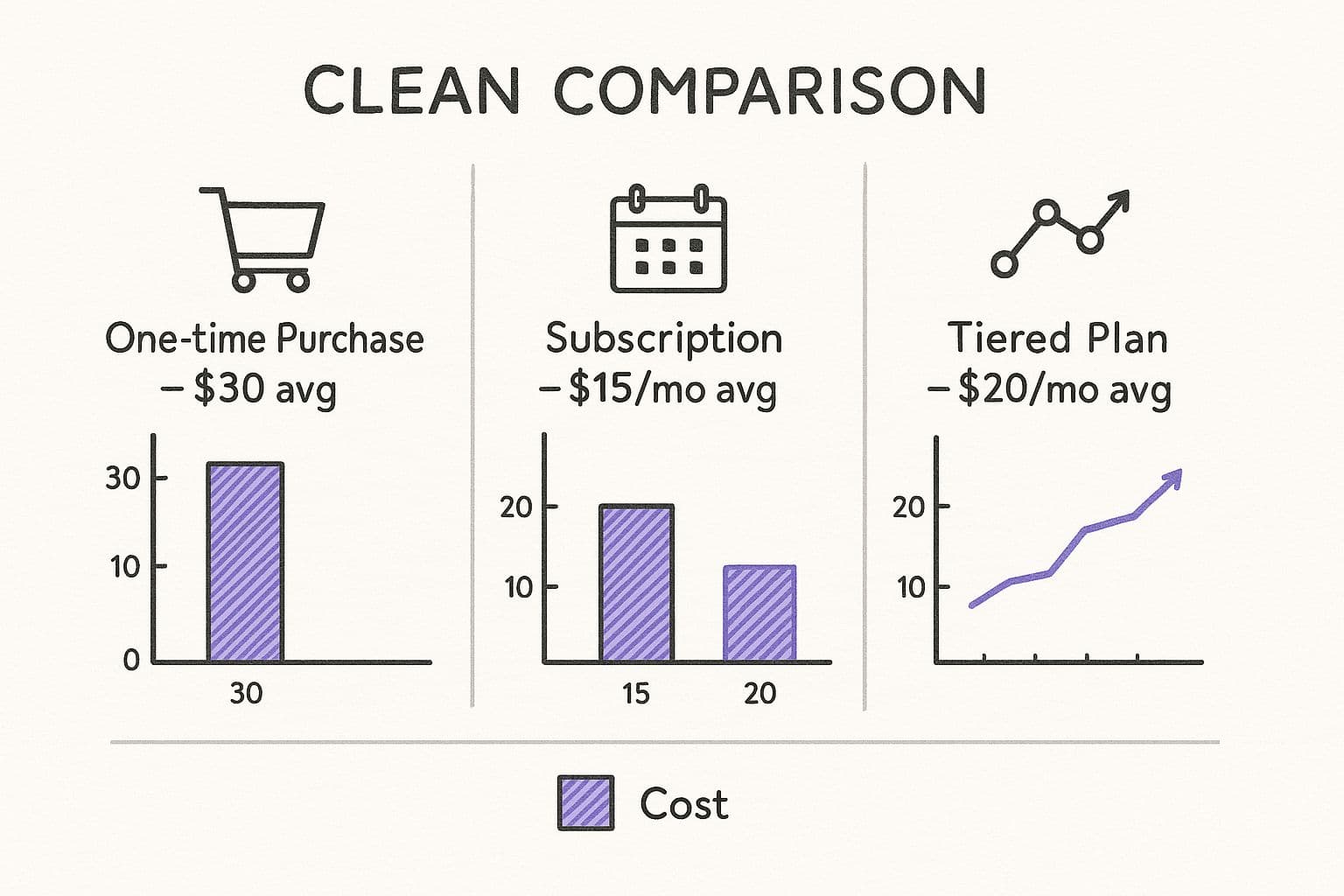Before you can even think about pricing or packaging your content, you need to get the foundation right. The most successful online content businesses aren't built on a whim; they're built on a rock-solid understanding of a specific audience's problems. Getting this first part right is everything.
Building Your Foundation to Sell Content

71d3fe2a-5f5a-48e1-b7d7-b87bb36c546d.jpg
Seriously, don't skip this bit. Too many creators jump straight to making stuff without a clear direction, and they almost always run out of steam. This initial phase is all about making a few smart, strategic decisions that will carry your entire business forward.
First up, you need to find a profitable niche. And a niche isn't just a topic you're into; it's a specific group of people who share a common, painful problem you can actually solve.
For example, "fitness" is way too broad. You'll get lost in the noise. But "postnatal fitness for new mums at home"? Now we're talking. That kind of focus makes it a hundred times easier to find your people and create content that feels like it was made just for them.
Choosing Your Niche and Platform
Once you've zeroed in on your niche, the next big decision is picking the right platform. Your choice here depends entirely on what you're selling and how you plan to run your business.
If you're building a community or want to offer ongoing value, a dedicated membership tool is probably your best bet. On the other hand, if you're just selling one-off digital products like an e-book, a simple payment processor might be all you need.
Think about these things when picking your home base:
- What are you selling? Video courses, e-books, a private community, or templates? Different platforms are built for different content types.
- What's your business model? Will you be charging for one-time purchases or a recurring subscription? Make sure the platform you choose handles your pricing strategy without needing a bunch of clunky workarounds. For instance, a tool like MyMembers is brilliant for managing recurring payments for exclusive Telegram communities.
- How tech-savvy are you? Be honest. Do you want a simple, no-code solution you can set up in an afternoon, or do you have the chops to build and manage a more complex custom site on WordPress?
Here's a real-world example: one blogger realised her audience of fellow bloggers really struggled with design. She enjoyed making templates in Canva for fun, so she decided to start selling them. She found the perfect sweet spot between what her audience needed and what she loved doing, turning a hobby into a £1,500+ per month side hustle just by solving their problem.
Analysing Market Demand
Finally, and this is crucial, you have to validate that people will actually pay for what you want to create. Don't just build it and hope they come. You need to do some digging to see if there's real demand for your idea.
Spend some time lurking in online forums, Facebook groups, and even the comment sections of your competitors. What are people talking about? What questions are they constantly asking? What are they complaining about?
These places are absolute goldmines. They give you direct insight into your audience's pain points. If you see people asking the same questions over and over, or complaining that there are no good resources on a particular topic, that's your signal.
It confirms that you're creating something people actually need, not just another piece of content in a sea of options. By checking for demand upfront, you're basically ensuring you have a built-in audience ready and waiting to buy.
Creating and Packaging High-Value Content
Alright, so you’ve figured out who you’re talking to and what keeps them up at night. Now for the fun part: turning your expertise into something people will actually pay for.

58f90555-5646-40da-93c9-a85221be7450.jpg
This is where your idea gets real. You’re moulding raw knowledge into a polished, high-value asset. The format you pick is just as critical as the information itself.
Some creators are natural writers, spinning up killer e-books or incredibly detailed guides. Others live on camera and are born to sell online courses with engaging tutorials that just click with viewers. Your choice should play to your strengths and, more importantly, how your audience likes to learn.
Here are a few popular formats that just work:
- E-books and Guides: Perfect for complex topics that need a structured, deep-dive approach. People love a good self-paced resource.
- Video Courses: The go-to for visual learners. Think software tutorials, coaching sessions, or anything where seeing it done makes all the difference. Our guide on how to sell online courses has a ton of specialised tips for this.
- Templates and Worksheets: These are pure, practical value. Canva templates, budget spreadsheets, printable planners—they’re all massive time-savers.
- Exclusive Community Access: Sometimes, the "content" isn't a file; it's the conversation. A private group where people can connect and get support is a powerful product, especially when managed with a tool like MyMembers.
Structuring Content for Maximum Impact
The fastest way to fail is to just dump all your knowledge onto a page and call it a day. That’s not a product; it’s a mess.
To sell content online effectively, you need to think like a guide. Your product has to lead the user from A to B, solving their problem one clear step at a time. No confusion. No guesswork.
For an e-book, that means a solid table of contents, chapters that build on each other, and summaries that drive the points home. For a video course, it means breaking down a big skill into bite-sized modules. Think of it like a flat-pack wardrobe—without the instructions, you've just got a pile of wood and a headache.
People aren't just paying for information; they're paying for convenience and clarity. They want a shortcut. Your job is to package your expertise so it gives them a direct path to the result they want, saving them from the frustration of figuring it all out themselves.
Production Quality Doesn't Mean a Hollywood Budget
Let's be clear: "high quality" doesn't mean you need to remortgage your house.
Today's tools are insane. Your smartphone can shoot better video than a professional camera from ten years ago. Free platforms like Canva let you design stunning e-book covers and worksheets without any design experience.
The real difference-maker is attention to detail. That’s what separates the amateurs from the pros.
This means:
- Clean audio in videos is a non-negotiable. People will forgive bad video, but they won’t tolerate bad audio.
- Proofread everything. Then proofread it again. Typos scream unprofessionalism.
- Consistent branding makes you look legit. Use the same colours, fonts, and logo everywhere.
Focus on creating an experience that feels premium. For instance, I saw a creator selling Canva templates for small businesses. They didn't just sell individual designs. They bundled them into themed kits.
One was an "Instagram Launch Kit" with 30 coordinated post templates, matching story graphics, and a mini branding guide. This approach massively inflates the perceived value. It becomes an irresistible offer compared to just selling one-off templates. This is how you turn simple ideas into seriously profitable digital products.
Choosing The Right Pricing Strategy
Picking a price for your content can feel more like art than science. It's also one of the most critical decisions you'll make.
Price it too low, and you're leaving cash on the table. Price it too high, and you might scare everyone off before you even get started. The sweet spot is finding a model that clicks with your content, your audience, and where you want to take your business long-term.
There are really three core ways to play this. You've got your simple one-off payments for quick cash flow, subscriptions for that sweet, predictable income, and tiered memberships that let you offer a bit of everything.
One-Off Payments vs Recurring Revenue
A one-time purchase is as straightforward as it gets. Think of it for standalone products like a killer e-book, a pack of design templates, or a single, in-depth video course. The customer pays once and owns it forever. It's a clean, low-commitment deal that’s easy for everyone to understand.
On the flip side, subscriptions are your best friend for content that's always evolving. This is the model for private communities, weekly newsletters packed with exclusive insights, or an ongoing series of tutorials. You're not just selling a product; you're building a relationship and a stable, predictable income stream. That recurring revenue is a game-changer for planning and growth.
And let's be honest, people are more comfortable than ever with paying online. With internet sales now making up around 27% of all retail spending in Great Britain, digital transactions are just part of life. You can see the full breakdown in the latest retail sales bulletin from the Office for National Statistics.
This infographic breaks down how these models stack up against each other.

cc050471-5bd3-432f-8393-12cb7c00c5b0.jpg
As you can see, a one-off purchase might look great upfront, but a subscription can squeeze so much more long-term value out of a single customer. It's a marathon, not a sprint.
Value-Based and Tiered Pricing
Your price shouldn't just be some number you plucked out of thin air. It needs to reflect the value you’re actually delivering. This is the heart of value-based pricing. Forget about just adding a bit of profit on top of your costs. Instead, anchor your price to the result or solution you provide.
Let’s say you’ve built an online course that helps freelance graphic designers land one extra client worth £500. Suddenly, charging £99 for that course doesn't just feel fair—it feels like an absolute steal. Always frame your price around the transformation you’re offering.
This thinking leads you straight into tiered pricing, which is a seriously powerful way to maximise your earnings. Tiers let you serve different parts of your audience who have different needs and, more importantly, different budgets.
A typical setup looks something like this:
- Basic Tier: The core stuff at an accessible price.
- Pro Tier: Everything in Basic, plus some juicy extras like worksheets or a bonus module.
- Premium Tier: The works. All the content plus exclusive access, like a 1-on-1 coaching call or entry into a private community.
The real trick here is to make your middle tier look like the obvious, no-brainer choice. By bracketing it with a cheaper basic option and a pricey premium one, the middle tier almost always comes across as the best bang for your buck.
To get the ball rolling, you can also use smart discounts or introductory offers to pull in your first wave of customers. For a deeper dive on how to do that without wrecking your brand, check out our guide on promotional pricing strategies. It's all about building that initial momentum without devaluing your work in the long run.
Now, let's break down these models side-by-side to help you figure out which one is the right fit for you.
Comparison of Content Pricing Models
Here’s a look at the three main pricing models to help you decide which is best for your online content business.
| Model | Best For | Pros | Cons |
|---|---|---|---|
| One-Time Purchase | Standalone products like e-books, templates, or single courses. | Simple for customers to understand. Upfront cash flow. Low commitment. | No recurring revenue. Constantly need to find new customers. |
| Subscription | Ongoing content like communities, newsletters, or tutorial series. | Predictable, recurring income. Builds strong customer relationships. High lifetime value. | Higher churn risk. Constant pressure to deliver new value. |
| Tiered Membership | Businesses with a diverse audience and multiple offerings. | Maximises revenue by catering to different budgets. Clear upsell path. | Can be complex to set up and manage. Potential for customer confusion. |
Choosing the right model is a foundational step. A one-time purchase is great for getting started, but if you're aiming for sustainable, long-term growth, the recurring revenue from subscriptions and tiered plans is where the real power lies. Don't be afraid to experiment and see what your audience responds to best.
Setting Up Payments and Secure Access

02a701e3-afb4-4360-808c-cbc8d5d65c95.jpg
Alright, your content is ready and you know what you’re charging. Now for the make-or-break part: actually getting paid.
This is where you build the bridge between your hard work and your customer’s wallet. Screw this up, and you’ll kill sales faster than anything. A clunky, sketchy checkout process screams amateur hour.
The goal? Make the journey from "Buy Now" to them getting the goods feel instant and automatic. This isn't just about making it easy; it's about building trust from the very first transaction. A pro payment setup shows you’re a serious business.
Integrating Your Payment Gateway
Your payment gateway is the engine that drives your sales. For most of us, Stripe is the undisputed king.
It’s crazy reliable, handles just about every currency you can think of, and it’s built to manage both simple one-off sales and tricky recurring subscriptions. Honestly, getting it set up is way easier than you'd think.
But Stripe is just one piece of the puzzle. You still need something to connect it to your website and actually control who gets access to what. This is where membership plugins and platforms come in. They’re the digital bouncers, granting access when a payment goes through and kicking people out if a subscription lapses.
Think of it as a digital vending machine. The customer slots in their card details (via Stripe), and your membership tool automatically spits out the correct product. You don't have to lift a finger. This automation is absolutely vital if you want to sell content online and not lose your mind.
Automating Content Delivery and Access
The real magic happens when your payment tool and your membership platform are talking to each other. A customer buys your e-book, and boom—an email with a secure download link hits their inbox. They sub to your private community, and they get an instant invite.
This is the standard. It’s what customers now expect. A solid setup should handle all of this for you:
- Instant Access: Automatically unlocks the content or fires off download links the second a payment clears. No waiting.
- Subscription Management: Deals with all the recurring billing headaches—renewal reminders, failed payment notifications—without you getting involved.
- Secure Logins: Creates a protected members-only area on your site where people can find everything they’ve bought from you.
Platforms like MyMembers were built for exactly this, turning something like a Telegram community into a product you can actually sell.
If you’re leaning towards a subscription model, it's worth checking out our guide on building a subscription website to see how all these parts fit together. Get this infrastructure right from the start, and you can get back to creating great stuff instead of drowning in admin.
Marketing Your Content to Drive Sales

embed
Making something great is only half the job. Now you have to get it in front of the right people. This is the part that separates a product that gathers digital dust from one that actually sells.
This isn’t about just shouting into the void and hoping for the best. It’s about building a genuine community around what you’ve made and gently guiding people from being interested followers to paying customers. If you want to sell content online and not just make it, your marketing needs to be just as good as your product.
A smart approach mixes building a real presence on social media with a solid email marketing game. When you get these two working together, you create a powerful engine that drives interest and, more importantly, sales.
Building Your Community on Social Media
Forget trying to be everywhere at once. That’s a recipe for burnout. Instead, put your energy where your ideal customers are already spending their time. For a lot of creators, especially in the UK, this means looking at platforms that pack a serious punch.
Social media is non-negotiable for selling content these days, and TikTok is a beast you can't ignore. As of early 2025, TikTok had 24.8 million UK users over the age of 18. That’s a staggering 74% penetration among 18-24-year-olds.
Think about that. People in that key demographic are spending an average of 64 minutes on the app every single day. This is a massive opportunity to grab their attention and turn it into real sales for your digital goods. You can dig deeper into these trends and what they mean for creators by checking out these insights on UK social media statistics.
The key is to give, not just take. Offer real value. Show behind-the-scenes stuff, share free tips that relate to your paid content, and actually reply to comments and questions. This is how you build the trust you need to turn a casual follower into a loyal customer.
Building a community is like tending a garden. You can't just plant a seed and expect it to grow. You need to nurture it daily with valuable content, genuine interaction, and a clear understanding of what your audience needs to flourish.
Leveraging Email Marketing and Smart SEO
Social media is fantastic for getting discovered, but email marketing is where you build the deep relationships that lead to sales. Your email list is a direct line to your most engaged audience—it's an asset you actually own and control.
Here’s how you can use your list:
- Announce New Content: Give your subscribers the first look at new products. A small early-bird discount for your most loyal fans works wonders.
- Nurture Leads: Set up a welcome email series that introduces new subscribers to who you are and what you're about. Give them some valuable freebies to show them what you've got.
- Share Your Best Stuff: Don't be shy. Highlight testimonials, case studies, or success stories from happy customers to build that all-important social proof.
Beyond your active promotion, you need a way to catch people who are already out there searching for what you offer. That's where some basic Search Engine Optimisation (SEO) comes in. By sprinkling relevant keywords throughout your blog posts and product descriptions, you help search engines figure out what your content is about, making it way easier for your target audience to find you on their own.
Think of it this way: social media creates the buzz, email marketing builds the relationship, and SEO works quietly in the background, bringing in new leads 24/7. When you combine these, you’re not just marketing—you're building a sustainable system for long-term growth. For more concrete ways to boost your sales, check out these proven book marketing strategies.
Got Questions About Selling Your Content? Yeah, Everyone Does.
Diving into selling your expertise online can feel like staring into the abyss. You’ve got the knowledge, you’ve got the drive, but a bunch of nagging questions are probably holding you hostage. It’s normal. Sorting out the details is how you go from anxious creator to confident business owner.
Let’s get these common questions out of the way. Once you’ve got clarity on the legal, technical, and growth stuff, you can get back to what you're actually good at: creating killer content.
The biggest question I hear? "Is it too late?" Absolutely not. The shift to buying digital goods isn't slowing down. In fact, forecasts for UK online retail show a healthy 4.5% growth heading into 2025. We're talking about a market worth over £120 billion. That's not a saturated market; it's a hungry one, full of fresh opportunities for people just like you. You can check out more on these UK retail trends to see what it means for your digital business.
What Legal Stuff Do I Actually Need to Worry About?
This is a smart question. No, you don't need a law degree, but ignoring the legal side is a rookie mistake that can cost you dearly. Getting a few basics in place protects both your content and your bank account.
- Copyright: The moment you create your original e-book, video, or course, it's automatically copyrighted in the UK. Slap a copyright notice (e.g., © 2025 Your Business Name) on it. It’s a clear "hands-off" sign to the world.
- Terms of Service & Privacy Policy: These aren't just legal fluff. A solid Terms of Service tells your customers exactly what they can (and can't) do with what they bought from you. A Privacy Policy isn't optional—it's legally required to explain how you handle customer data.
Look, spend a bit of cash on some high-quality legal templates from a reputable source, or have a quick chat with a legal pro. It might feel like a boring expense now, but it’ll save you from catastrophic headaches later. Build your house on rock, not sand.
How Do I Scale This Without Burning Out?
Starting small is smart. But thinking about growth from day one is even smarter. Scaling isn't about working 80-hour weeks; it's about building systems that do the heavy lifting for you.
Automation is your new best friend. You need a system that handles payments, delivers content, and manages members without you touching a thing. This is non-negotiable. It frees you from being a glorified admin so you can create more valuable stuff or find new ways to market what you've already made.
Think about it. A fitness coach can start by selling a single PDF workout plan. To scale, they could launch a subscription for weekly workout videos and meal plans. With a tool built for memberships, they can manage hundreds of subscribers with the same effort it took to handle ten one-off sales.
That's how you scale an online content business. You build a machine.
Ready to turn your Telegram community into a recurring revenue stream? MyMembers provides the seamless integration with Stripe to automate payments, manage subscriptions, and deliver exclusive content instantly. Start building your membership business today at https://mymembers.io.
